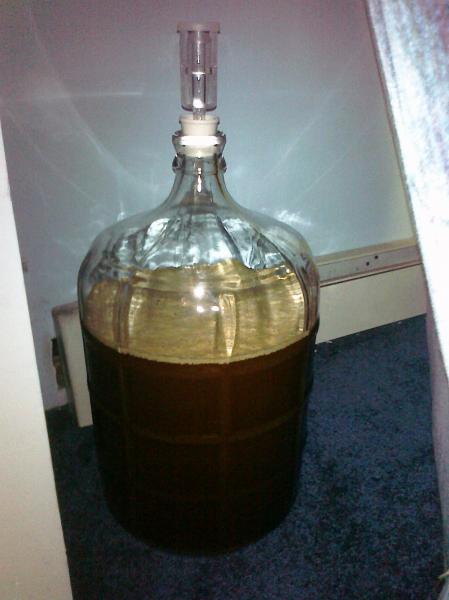thedude00
Well-Known Member
I just finished racking my first brew last night. It looks like it is still Fermenting bubbles still in the airlock. Is this normal in a Secondary?
Heres a look

Heres a look




Clearing: Racking to Secondary Vs. Long Primary
To Secondary:
Pros:
* Results in really clear beer
* If all you have available is a bucket and a 5 gallon carboy, racking the beer to secondary can free up a fermenter for a new batch. Can you say pipeline?
* Sounds really cool when you're explaining it to your non homebrewer friends. Yeah man, today I racked 5 gallons of Russian Imperial Stout to secondary. I'm hoping it turns out nicely. They might not have any idea what you're talking about, but it does sound cool
* Reduces the risk of autolysis if you're planning on bulk aging for a very long time
* If you're going to add fruit to your beer, now is the time
Cons:
* Anytime you rack your beer, you risk oxidation, no matter how careful you are. If you're very careful, you can minimize the risk, but it's still >0
* Anytime you rack your beer, you risk infection. You can minimize this as well by carefully sanitizing all your siphon gear and your secondary vessel, but it's still >0
* It requires another vessel. You have to purchase one, which costs money. You have to clean it, which costs time. And you have to sanitize it, which costs sanitizer and time.
Or Not to Secondary:
Pros:
* Only requires 1 fermentation vessel. Fewer fermenters means less cleaning
* Has pretty much the same effect as using a secondary if you're patient enough to wait a month or so
* Much less effort required. Just leave it alone for a long time
* Many styles of beer are meant to be a bit cloudy
* With something dark like a stout, who cares if it's clear? It's not like you can tell
* No additional risk of oxidation or infection
Cons:
* You can't add fruit. Well, you can, but you want to wait at least a week or so before you do. I probably wouldn't
* Too long of a primary can result in autolysis. This isn't even really a concern unless we're talking >6 months in primary







![Craft A Brew - Safale S-04 Dry Yeast - Fermentis - English Ale Dry Yeast - For English and American Ales and Hard Apple Ciders - Ingredients for Home Brewing - Beer Making Supplies - [1 Pack]](https://m.media-amazon.com/images/I/41fVGNh6JfL._SL500_.jpg)




Everything looks fine, the only thing is that it appears to have quite a lot of fermentation going on (based on the frothy head). I would tend to see little or no fermentation when I move to secondary.
How long did you leave it in primary, and did you take a hydrometer reading before moving to secondary?
Don't panic. You didn't mess up your beer. It's not that unusual to still have "foam" on top of the beer. It could mean that you racked before the fermentation was complete, but 7 days on an ale, especially with honey is should be plenty. The only other variables are temp in your brew room and SG. Cold temps, like around 60F, can slow fermentation. SG's above 1.060 can take longer to finish. Either way, leave it in the secondary for a couple of weeks and take a hydro reading. If your hydro reading is within the acceptable FG range for the beer, go ahead and prime and bottle. When in doubt, use your hydrometer. At this point, you just want to avoid making bottle bombs.
I will make it a point to test more offen. Thanks again
Don't panic. You didn't mess up your beer. It's not that unusual to still have "foam" on top of the beer. It could mean that you racked before the fermentation was complete, but 7 days on an ale, especially with honey is should be plenty. The only other variables are temp in your brew room and SG. Cold temps, like around 60F, can slow fermentation. SG's above 1.060 can take longer to finish. Either way, leave it in the secondary for a couple of weeks and take a hydro reading. If your hydro reading is within the acceptable FG range for the beer, go ahead and prime and bottle. When in doubt, use your hydrometer. At this point, you just want to avoid making bottle bombs.